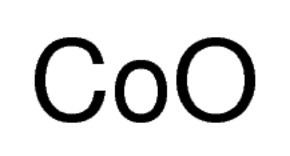Formula CoO Density 6.44 g/cm³ | Molar mass 74.9326 g/mol Appearance black powder | |
 | ||
Related compounds | ||
Cobalt(II) oxide or cobalt monoxide is an inorganic compound that appears as olive-green to red crystals, or as a greyish or black powder. It is used extensively in the ceramics industry as an additive to create blue colored glazes and enamels as well as in the chemical industry for producing cobalt(II) salts.
Contents
Structure and properties
CoO crystals adopt the periclase (rock salt) structure with a lattice constant of 4.2615 Å.
It is antiferromagnetic below 16 °C.
Preparation
Cobalt(II,III) oxide decomposes to cobalt(II) oxide at 950 °C:
2 Co3O4 → 6 CoO + O2Though commercially available, cobalt(II) oxide may be prepared in the laboratory by electrolyzing a solution of cobalt(II) chloride.
CoCl2 + H2O → CoO + H2 + Cl2
It may also be prepared by precipitating the hydroxide, followed by thermal dehydration:
CoX + 2 KOH → Co(OH)2 + K2XCo(OH)2 → CoO + H2OReactions
As can be expected, cobalt(II) oxide reacts with mineral acids to form the corresponding cobalt salts:
CoO + 2 HX → CoX2 + H2OApplications
Cobalt(II) oxide has for centuries used as a coloring agent on kiln fired pottery. The additive provides a deep shade of blue named cobalt blue. The band gap (CoO) is around 2.4 eV. It also is used in cobalt blue glass.
